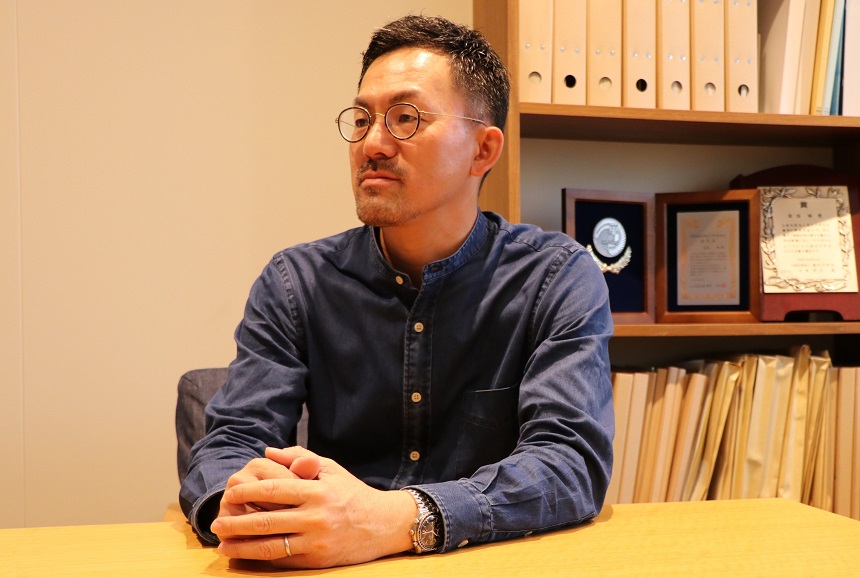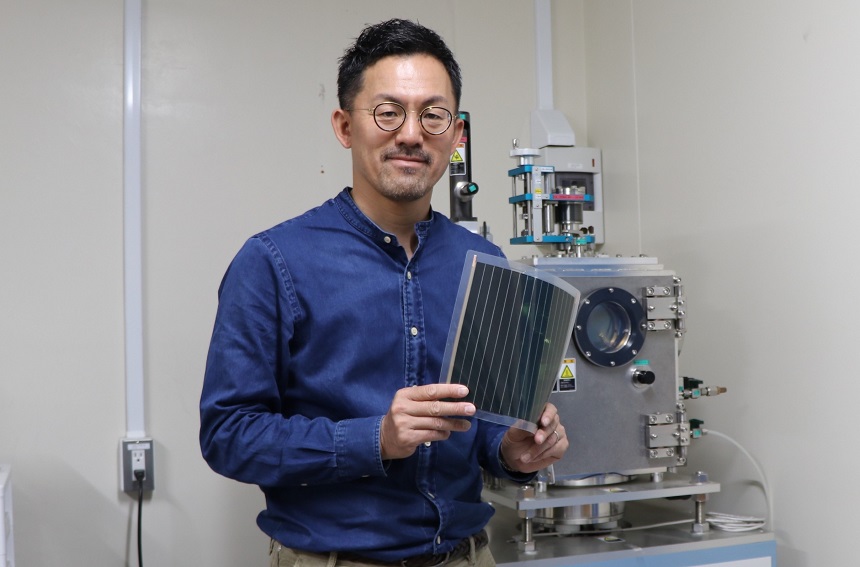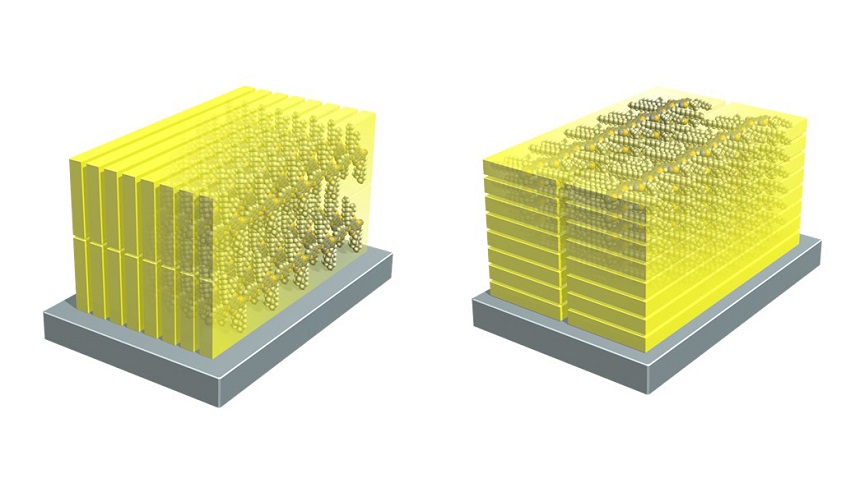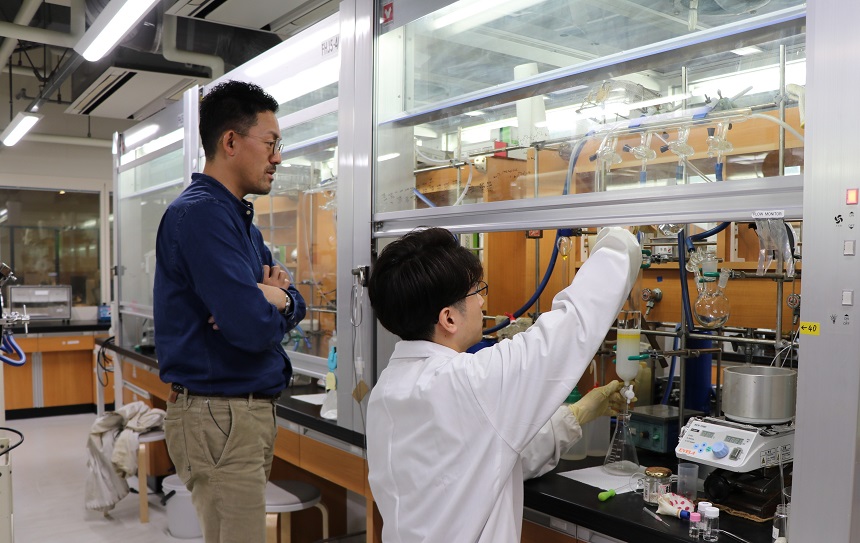On February 1, 2013, Hiroshima University established two new programs: the “Distinguished Professors” (DP) program and the “Distinguished Researchers” (DR) program. Individuals who are part of these programs are recognized as senior and junior faculty members respectively, who are engaged in extraordinarily distinguished research activities.
Interview of Distinguished Professor Itaru Osaka

Using π-conjugated Polymers, Plastics That Conduct Electricity, to Create Electronic Devices That Benefit the Lives of People around the World
Making Thin, Light, and Flexible Electronic Devices out of Plastic
Plastic, a material we are all familiar with, is used in a wide variety of products, but it usually does not conduct electricity. However, plastics called conductive polymers discovered by Professor Hideki Shirakawa, who was awarded the Nobel Prize in Chemistry in 2000, do conduct electricity. In recent years, materials developed from his discovery have been used in a variety of electronic products, such as touch panels for smartphones and lithium-ion batteries, making them indispensable to modern society. Conductive polymers are a kind of material known as π-conjugated polymers, and I have been researching their evolution ever since I was assigned to Professor Shirakawa's laboratory at the University of Tsukuba. In 2006, I went to the United States to study, and since then I have been conducting research on the application of π-conjugated polymers to electronic devices as the semiconductor.
Today's devices, including smartphones, computers, LEDs for displays and lighting, and solar cells, are made of inorganic materials such as silicon as the semiconductor and metal and glass as the substrate and other components. As a result, they are heavy and rigid. However, if we use π-conjugated polymers, they can be made of plastics, that is, organic materials (both the semiconductor and substrate), and it is possible to create devices that are light, thin, and soft. If solar cells were made of plastics, it would be possible to make them light, thin, and translucent by forming them into a film. They could be attached to the walls of buildings or emergency tents in times of disaster to generate electricity, or made translucent and attached to house windows or agricultural greenhouses to generate electricity while allowing light to pass through. In the future, we can expect to see the appearance of a series of devices with completely different possibilities from the heavy, black, and rigid solar cells of the past.

Flexible solar cells using π-conjugated polymers developed by Professor Osaka
Designing the Orientation of Polymers for Efficient Electron Transport
In order to make such dream devices a reality, I am currently working on research to improve the performance of solar cells made of π-conjugated polymers. The performance of a solar cell depends on how much light it can absorb and convert into electricity with high efficiency. To achieve this, it is important to have an arrangement of polymers that can smoothly transport electrons to the electrodes during the process of converting light into electrons. π-conjugated polymers are macromolecules, which means that they are made up of many molecules connected like long udon noodles. In order for electrons to flow smoothly, it is important that the molecules are not randomly lined up in an amorphous state, but are arranged in a neat state like snow crystals, and that they overlap vertically in a plate-like form. This orderly arrangement of molecules is called "orientation."
We first design the chemical structure of the molecule on a computer using quantum chemical calculations, a method for predicting the state of molecules and atoms, and then brush up the chemical structure to achieve the ideal orientation of the molecule based on the calculated molecular shape and previous findings. The next step is to synthesize a polymer with the designed molecular structure by mixing various reagents in a flask and reacting them, and then test whether it really performs the desired function. The structures of the molecules that make up organic materials are so tiny that they cannot be seen even with an electron microscope. However, by designing the molecular structure and the self-assembled structure built up by the molecules in our minds and actually synthesizing it, we may be able to create new materials that have never existed in this world before, which can perform the functions we have envisioned. This is what makes this research so interesting and so rewarding.

Controlling the arrangement of molecules to improve the performance of solar cells made of π-conjugated polymers
Our Wish Is to Create New Materials That Will Change People's Lives around the World
Our research group has already established the technology to control the orientation of π-conjugated polymer solar cells to some extent. In a paper published in 2015, we reported how we were the first in the world to achieve the milestone of 10% energy conversion efficiency for organic thin-film solar cells by using the orientation control technology we developed. Currently, it is common knowledge worldwide that molecular orientation control is extremely important to improve the conversion efficiency of organic thin-film solar cells, but no one has yet achieved a conversion efficiency of 20%, which is comparable to that of silicon solar cells, and one of our current goals is to lead the world in achieving this target.
As a further goal, we hope to apply π-conjugated polymers not only to solar cells, but also to other ways of generating and utilizing energies. One possibility is to apply them to materials that generate electricity from heat, called thermoelectric conversion elements. Currently, inorganic materials are generally used for thermoelectric conversion elements, but there have been some studies suggesting that organic materials could also be used, which is something we are paying attention to. In addition, π-conjugated polymers can be used as photocatalysts to split water to hydrogen and oxygen using light energy, thereby extracting hydrogen, and reducing carbon dioxide in the air, thus contributing to global carbon neutrality.
I have been conducting research on π-conjugated polymers for a long time now, and I hope that one day the materials I have developed will be released into the world and into the hands of people everywhere. Our lives today are made possible by the many innovative materials created by the scientists of the past. I will continue my research with the goal of creating materials that will make the lives of people around the world more convenient and lead to the happiness of humankind.


 Home
Home